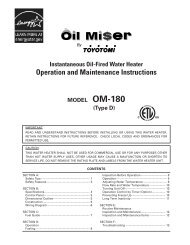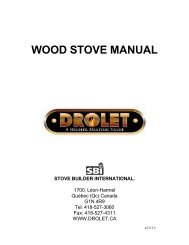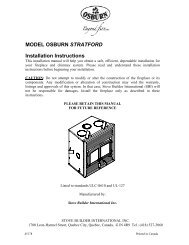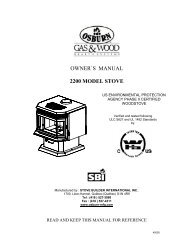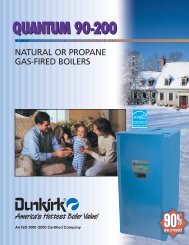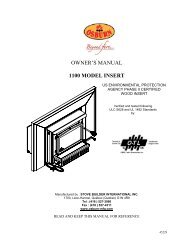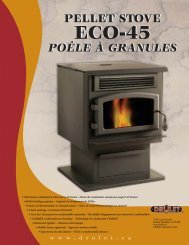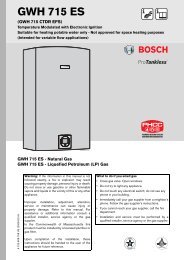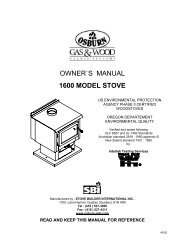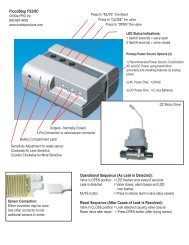Owner's Manual Osburn 2000 Wood Stove Insert - Rural Energy ...
Owner's Manual Osburn 2000 Wood Stove Insert - Rural Energy ...
Owner's Manual Osburn 2000 Wood Stove Insert - Rural Energy ...
Create successful ePaper yourself
Turn your PDF publications into a flip-book with our unique Google optimized e-Paper software.
4.2. CORDWOOD FUEL<br />
1. Fuel for the insert must not be stored closer than the required clearances to combustibles<br />
and not in the space required for ash removal.<br />
2. Your <strong>Osburn</strong> insert is designed to burn CORDWOOD FUEL ONLY. Do not burn coal,<br />
charcoal, or trash in the unit. Highly flammable items such as trash may ignite creosote in<br />
the chimney, resulting in a chimney fire. Never burn salt wood, beachwood, chemically<br />
treated wood, or wood removed from salt water, since the deposits left will deteriorate the<br />
firebox. Damage caused by chemicals or salt is not covered under warranty.<br />
3. Seasoned dense wood is recommended. <strong>Wood</strong> should be air dried in a covered<br />
ventilated area for six months to a year or more. This reduces the moisture content of the<br />
wood, resulting in better insert performance. <strong>Wood</strong> species with a moisture content of<br />
20% or less are ideal. Dry seasoned wood can be distinguished from green wood by the<br />
checks or cracks in the ends.<br />
4. Wet or green wood will tend to cause the fire to smoulder, producing large amounts of<br />
creosote. Creosote build-up could result in a chimney fire. This wood will also prove<br />
difficult to keep burning properly, and fires will tend to go out. Green wood produces very<br />
little heat, and sometimes causes customers to think that the insert does not work. If you<br />
must burn wet wood, use only small amounts mixed with dry wood.<br />
5. Decayed wood or low density wood has very little energy content or heating value, and will<br />
not burn satisfactorily for long periods of time.<br />
An example of the energy values of some common wood fuels is given in Table 4.1<br />
For recommended wood sizes, refer to the specifications.<br />
Common Heating Values of Cordwood<br />
Hardwoods Million Btu/Cord Softwoods Million Btu/Cord<br />
Birch 23.6 Douglas Fir 20.6<br />
White Oak 28.3 Hemlock 17.1<br />
Alder 17.6 Jack Pine 18.4<br />
Table 4.1<br />
18



